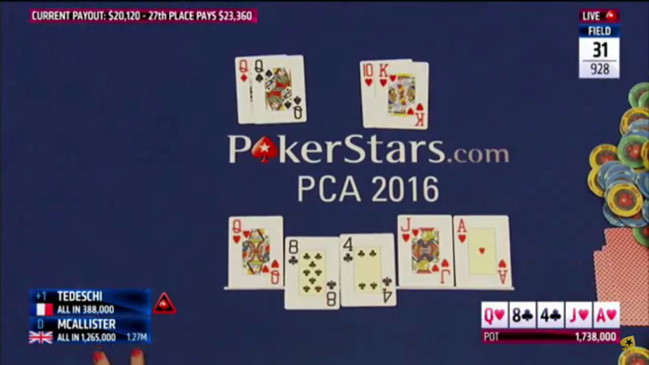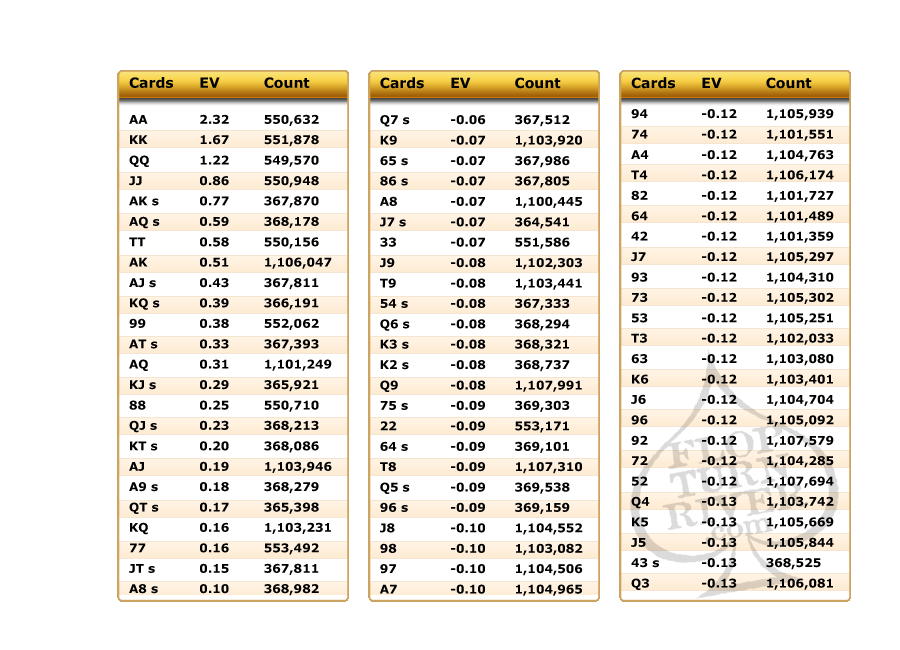- Odds Of Hitting Quads In Texas Hold'em
- Odds Of Flopping Quads In Texas Holdem
- Odds Of Making Quads In Texas Holdem


The following Texas Holdem odds table highlights some common probabilities that you may encounter in Hold'em. It is not vital that you learn these probabilities, but it is useful to be aware of the chances of certain situations arising.
Texas Hold'em odds chart.
| Situation | Percentage Odds | Ratio Odds |
|---|---|---|
| Preflop Probabilities: | ||
| Dealt AA. | 0.45% | 220 to 1 |
| Dealt AK. | 1.2% | 82 to 1 |
| Dealt AKs. | 0.3% | 331 to 1 |
| Dealt 72o. | 0.9% | 109 to 1 |
| Being dealt AA vs. KK (heads up). | 0.004% | 22,559 to 1 |
| Dealt a pocket pair. | 6% | 16 to 1 |
| Dealt suited connectors. | 4% | 24 to 1 |
| Flop Probabilities: | ||
| Flopping a pair. | 32.4% | 2.2 to 1 |
| Flopping a set (with pockets). | 11.8% | 7.5 to 1 |
| Paired Board: | ||
| 2 players, probability of trips. | 17% | 4.8 to 1 |
| 3 players, probability of trips. | 26% | 3 to 1 |
| 4 players, probability of trips. | 34% | 2 to 1 |
| 5 players, probability of trips. | 43% | 1.4 to 1 |
In No Limit Hold'em, a player has about a 2% chance of having quads by the river while they hold a pocket pair. In No Limit Hold'em, a player has about a 0.001% chance of flopping quads without a pocket pair. Quads are beaten by just three types of hands: 1. Poker Odds and Charts Chances of hitting, flopping and holding certain hands. These odds are a must know if you want to advance your game to a high level. For exact odds you can check out our poker hand odds calculator. We rounded the number to the nearest decimal for you. The probability of being dealt a pair in Texas Hold’em is 5.88%, or odds of 1: 16. There are 13 pairs in Hold’em (22 – AA) and for each there are 6 ways to be dealt. There are 6 different ways to form a specific pair and there are 13 different pairs. Meaning there are. Check out the Holdem pair pre-flop odds in high resolution universal.pdf format. High Card Hands (Unpaired) Whoever said that Holdem is a high card game was right. Much of the overall Holdem action involves two unpaired high cards like the typical hands illustrated above.
How to use Texas Hold'em odds.
The odds in this Texas Hold'em odds table are unlikely to directly help your overall strategy, but they are pretty interesting nonetheless. The Texas Hold'em odds for each of the different situations have been given in both percentage and ratio odds, so use whichever format you feel comfortable with.

Other poker odds charts.

For more useful odds charts that you can use for when you are working out whether or not to call when on a drawing hand, use the following tables:
Both of these tables give the odds for completing your draw depending on how many outs you have. You can find out more on how to work out odds and all that mathematical stuff in the article on pot odds.
Go back to the poker odds charts.

Can You Afford Not To Use
Poker Tracker 4?
Odds Of Hitting Quads In Texas Hold'em
“I wouldn’t play another session of online poker without it”
“I play $25NL, and in under 1 week PT4 had paid for itself”
Odds Of Flopping Quads In Texas Holdem
Comments
Playing poker is about playing the odds. The following list gives the odds for outcomes in Texas Hold’em hands. When you realize how heavily the odds are stacked against you, you may want to rethink going all-in before the flop with two suited cards. Use the odds to your advantage:
Odds Of Making Quads In Texas Holdem
1 percent (1-in-100): Percentage of time that no player holds an Ace or a King at a table in a 10-handed game
1 percent (1-in-100): Percentage of time that if you hold two suited cards, you’ll flop a flush
6 percent (about 1-in-20): Percentage of time that five community cards will give pocket suited cards a flush
6 percent (about 1-in-20): Percentage of time that you’ll be dealt a pocket pair
8 percent (about 1-in-12): Percentage of time that you’ll hit at least trips after having a pair on the flop
12 percent (about 1-in-8): Percentage of time that you’ll flop trips if holding a pocket pair
12 percent (about 1-in-8): Percentage of time that two more cards will flop in the same suit as a suited pocket pair
19 percent (about 1-in-5): Percentage of time that the five community cards will at least trip your pocket pair
32 percent (about 1-in-3): Percentage of time that you’ll pair one of your cards on the flop (with no pocket pair)
33 percent (about 1-in-3): Percentage of time that you’ll make a full house or better after having trips on the flop
35 percent (about 1-in-3): Percentage of time that you’ll make a flush on the turn or river if you have four cards to a flush after the flop
